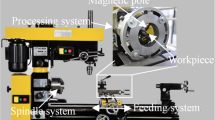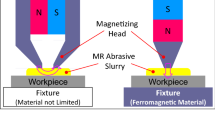Abstract
A novel magnetic abrasive finishing (MAF) technique employing a rotating magnetic disc is developed to address the issue of uneven polishing on large-sized slender tubes. The method involves arranging a series of magnetic poles in an S–N-S–N configuration on a pair of rotating discs, with the tubes being processed fed between the gap of the two discs. This approach results in a 246% increase in finishing efficiency compared to traditional MAF processes, where only the workpiece rotates. The finishing characteristics are determined by the interaction of the magnetic abrasive particles (MAPs) with the tube’s outer surface. This interaction is regulated by the magnetic field distribution on the surface and the contact trajectory density of the MAPs. The S–N-S–N magnetic pole configuration defines the magnetic field characteristics, which in turn control the magnetic force and the contact trajectory required for the MAPs behavior. An experimental design method was employed to determine the optimal process for a 5-m-long zirconium alloy cladding tube, utilizing a high-speed feeding rate of 5 m/min. Even at high feed rates, the tube’s surface can be processed with dense trajectories and consistent results. The outer surface roughness of the zirconium alloy cladding tube was reduced by 31%, from 0.356 to 0.247 µm, after a single-pass treatment. Following MAF processing, the final roughness can reach 0.126 µm.














Similar content being viewed by others
References
Gussev MN, Garrison B, Massey C, Le CA, Linton K, Terrani KA (2023) A correlation-based approach for evaluating mechanical properties of nuclear fuel cladding tubes. J Nucl Mater 574:154192. https://doi.org/10.1016/j.jnucmat.2022.154192
Li JY, Fan ZH, Yang ZH, Tian YB, Gao J (2023) Simulation and modeling of magnetorheological shear thickening polishing processes for slender tube. J Mater Res Technol 25:480–496. https://doi.org/10.1016/j.jmrt.2023.05.226
Akhiani H, Szpunar JA (2013) Effect of surface roughness on the texture and oxidation behavior of zircaloy-4 cladding tube. Appl Surf Sci 285:832–839. https://doi.org/10.1016/j.apsusc.2013.08.137
Szymański M, Przestacki D, Szymański P (2022) Tool wear and surface roughness in turning of metal matrix composite built of Al2O3 sinter saturated by aluminum alloy in vacuum condition. Materials 15:8375. https://doi.org/10.3390/ma15238375
Platt P, Allen V, Fenwick M, Gass M, Preuss M (2015) Observation of the effect of surface roughness on the oxidation of zircaloy-4. Corrs Sci 98:1–5. https://doi.org/10.1016/j.corsci.2015.05.013
Chaudhari AR, Judal KB (2022) Development and experimentation of modified electro-chemical magnetic abrasive finishing. Mater Manuf Process 37:448–457. https://doi.org/10.1080/10426914.2021.2016822
Mosavat M, Rahimi A (2019) Numerical-experimental study on polishing of silicon wafer using magnetic abrasive finishing process. Wear 424–425:143–150. https://doi.org/10.1016/j.wear.2019.02.007
Li WS, Li JJ, Cheng B, Zhang XJ, Song Q, Wang Y, Zhang T, Seniuts U, Belotsrkovsky M (2021) Achieving in-situ alloy-hardening core-shell structured carbonyl iron powders for magnetic abrasive finishing. Mater Design 212:110198. https://doi.org/10.1016/j.matdes.2021.110198
Dixit N, Sharma V, Kumar P (2021) Research trends in abrasive flow machining: a systematic review. J Manuf Process 64:1434–1461. https://doi.org/10.1016/j.jmapro.2021.03.009
Lv S, Wei W, Qiao Y (2023) Study on the effect of magnetic needle grinding on the surface integrity and service performance of medical Mg-0.8Ca alloy. J Phys: Conf Ser 2469:012021. https://doi.org/10.1088/1742-6596/2469/1/012021
Fu YZ, Wang XP, Gao H, Wei HB, Li SC (2016) Blade surface uniformity of blisk finished by abrasive flow machining. Int J Adv Manuf Technol. https://doi.org/10.1007/s00170-015-8270-0
Sambharia JK, Mali HS, Garg V (2018) Experimental investigation on unidirectional abrasive flow machining of trim die workpiece. Mater Manuf Process 33:651–660. https://doi.org/10.1080/10426914.2017.1364847
Grover V, Singh AK (2017) A novel magnetorheological honing process for nano-finishing of variable cylindrical internal surfaces. Mater Manuf Process 32:573–580. https://doi.org/10.1080/10426914.2016.1257801
Song WL, Peng Z, Li PF, Shi P, Choi SB (2020) Annular surface micromachining of titanium tubes using a magnetorheological polishing technique. Micromachines-Basel 11:314. https://doi.org/10.3390/mi11030314
Amir M, Mishra V, Sharma R, Iqbal F, Ali SW, Kumar S, Khan GS (2023) Development of magnetic nanoparticle based nanoabrasives for magnetorheological finishing process and all their variants. Ceram Int 49:6254–6261. https://doi.org/10.1016/j.ceramint.2022.11.033
Wang Y, Hu D (2005) Study on the inner surface finishing of tubing by magnetic abrasive finishing. Int J Mach Tool Manu 45:43–49. https://doi.org/10.1016/j.ijmachtools.2004.06.014
Ahmad S, Gangwar S, Yadav PC, Singh DK (2017) Optimization of process parameters affecting surface roughness in magnetic abrasive finishing process. Mater Manuf Process 32:1723–1729. https://doi.org/10.1080/10426914.2017.1279307
Qian C, Fan ZH, Tian YB, Liu YH, Han JG, Wang JH (2021) A review on magnetic abrasive finishing. Int J Adv Manuf Technol 112:619–634. https://doi.org/10.1007/s00170-020-06363-x
Nagdeve L, Dhakar K, Kumar H (2020) Development of novel finishing tool into magnetic abrasive finishing process of aluminum 6061. Mater Manuf Process 35:1129–1134. https://doi.org/10.1080/10426914.2020.1767295
Deng YM, Zhao YG, Zhao GY, Gao YW, Liu GX, Wang K (2022) Study on magnetic abrasive finishing of the inner surface of Ni–Ti alloy cardiovascular stents tube. Int J Adv Manuf Technol 118:2299–2309. https://doi.org/10.1007/s00170-021-08074-3
Yamaguchi H, Kang J, Hashimoto F (2011) Metastable austenitic stainless steel tool for magnetic abrasive finishing. CIRP Ann-Manuf Techn 60:339–342. https://doi.org/10.1016/j.cirp.2011.03.119
Judal KB, Yadava V, Pathak D (2013) Experimental investigation of vibration assisted cylindrical–magnetic abrasive finishing of aluminum workpiece. Mater Manuf Process 28:1196–1202. https://doi.org/10.1080/10426914.2013.811725
Singh G, Singh AK, Garg P (2017) Development of magnetorheological finishing process for external cylindrical surfaces. Mater Manuf Process 32:581–588. https://doi.org/10.1080/10426914.2016.1221082
Singh M, Singh A, Singh AK (2018) A rotating core-based magnetorheological nano-finishing process for external cylindrical surfaces. Mater Manuf Process 33:1160–1168. https://doi.org/10.1080/10426914.2017.1328116
Heng LD, Kim JS, Tu JF, Mun SD (2020) Fabrication of precision meso-scale diameter ZrO2 ceramic bars using new magnetic pole designs in ultra-precision magnetic abrasive finishing. Ceram Int 46:17335–17346. https://doi.org/10.1016/j.ceramint.2020.04.022
Shinmura T, Takazawa K, Hatano E, Matsunaga M, Matsuo T (1990) Study on magnetic abrasive finishing. CIRP Ann-Manuf Techn 39:325–328. https://doi.org/10.1016/S0007-8506(07)61064-6
Jain VK (2009) Magnetic field assisted abrasive based micro-/nano-finishing. J Mater Process Tech 209:6022–6038. https://doi.org/10.1016/j.jmatprotec.2009.08.015
Kwak JS (2009) Enhanced magnetic abrasive polishing of non-ferrous metals utilizing a permanent magnet. Int J Mach Tool Manu 49:613–618. https://doi.org/10.1016/j.ijmachtools.2009.01.013
Funding
This work is supported by the National Key Research and Development Program of China (2022YFE0121900; Recipient: WL), the Major Project of Science and Technology of Gansu Province (21ZD4WA017; Recipient: WL), the Major Special Projects of Gansu Province (22ZD6GA008; Recipient: XZ), and the National Natural Science Foundation of China (51901093; Recipient: BC).
Author information
Authors and Affiliations
Contributions
XZ: conceptualization, writing—original draft, writing—reviewing and editing; XZ: data curation; BC: investigation; HW: methodology; WL: project administration; CF: formal analysis; US: methodology.
Corresponding author
Ethics declarations
Conflict of interest
The authors declare no competing interests.
Additional information
Publisher's Note
Springer Nature remains neutral with regard to jurisdictional claims in published maps and institutional affiliations.
Rights and permissions
Springer Nature or its licensor (e.g. a society or other partner) holds exclusive rights to this article under a publishing agreement with the author(s) or other rightsholder(s); author self-archiving of the accepted manuscript version of this article is solely governed by the terms of such publishing agreement and applicable law.
About this article
Cite this article
Zhang, X., Zhao, X., Cheng, B. et al. Design and processing behavior of large tubes with a rotating magnetic pole core-based magnetic abrasive finishing. Int J Adv Manuf Technol 130, 1709–1721 (2024). https://doi.org/10.1007/s00170-023-12754-7
Received:
Accepted:
Published:
Issue Date:
DOI: https://doi.org/10.1007/s00170-023-12754-7




